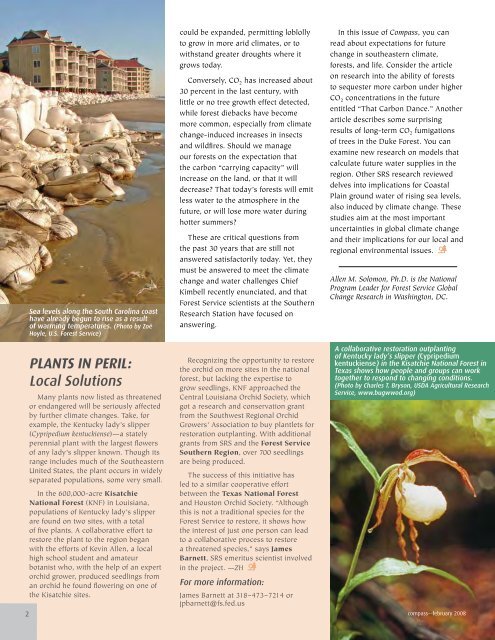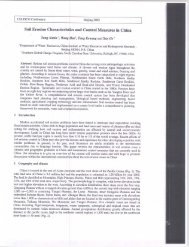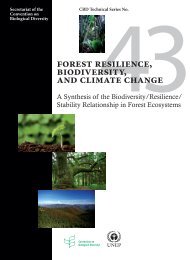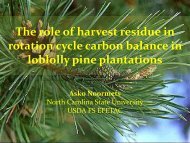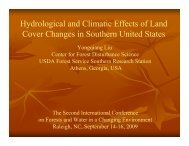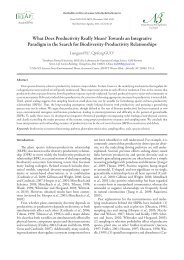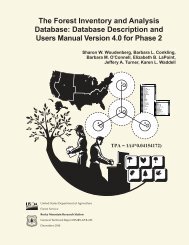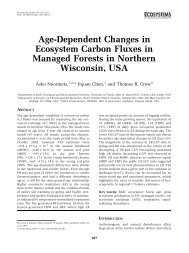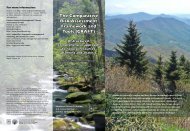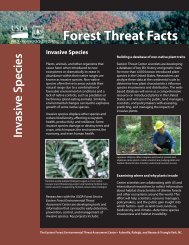What do forests have to do with global climate change? What do ...
What do forests have to do with global climate change? What do ...
What do forests have to do with global climate change? What do ...
Create successful ePaper yourself
Turn your PDF publications into a flip-book with our unique Google optimized e-Paper software.
PLANTS IN PERIL:<br />
Local Solutions<br />
Many plants now listed as threatened<br />
or endangered will be seriously affected<br />
by further <strong>climate</strong> <strong>change</strong>s. Take, for<br />
example, the Kentucky lady’s slipper<br />
(Cypripedium kentuckiense)—a stately<br />
perennial plant <strong>with</strong> the largest flowers<br />
of any lady’s slipper known. Though its<br />
range includes much of the Southeastern<br />
United States, the plant occurs in widely<br />
separated populations, some very small.<br />
In the 600,000-acre Kisatchie<br />
National Forest (KNF) in Louisiana,<br />
populations of Kentucky lady’s slipper<br />
are found on two sites, <strong>with</strong> a <strong>to</strong>tal<br />
of five plants. A collaborative effort <strong>to</strong><br />
res<strong>to</strong>re the plant <strong>to</strong> the region began<br />
<strong>with</strong> the efforts of Kevin Allen, a local<br />
high school student and amateur<br />
botanist who, <strong>with</strong> the help of an expert<br />
orchid grower, produced seedlings from<br />
an orchid he found flowering on one of<br />
the Kisatchie sites.<br />
2<br />
Sea levels along the South Carolina coast<br />
<strong>have</strong> already begun <strong>to</strong> rise as a result<br />
of warming temperatures. (Pho<strong>to</strong> by Zoë<br />
Hoyle, U.S. Forest Service)<br />
could be expanded, permitting loblolly<br />
<strong>to</strong> grow in more arid <strong>climate</strong>s, or <strong>to</strong><br />
<strong>with</strong>stand greater droughts where it<br />
grows <strong>to</strong>day.<br />
Conversely, CO 2 has increased about<br />
30 percent in the last century, <strong>with</strong><br />
little or no tree growth effect detected,<br />
while forest diebacks <strong>have</strong> become<br />
more common, especially from <strong>climate</strong><br />
<strong>change</strong>-induced increases in insects<br />
and wildfires. Should we manage<br />
our <strong>forests</strong> on the expectation that<br />
the carbon “carrying capacity” will<br />
increase on the land, or that it will<br />
decrease? That <strong>to</strong>day’s <strong>forests</strong> will emit<br />
less water <strong>to</strong> the atmosphere in the<br />
future, or will lose more water during<br />
hotter summers?<br />
These are critical questions from<br />
the past 30 years that are still not<br />
answered satisfac<strong>to</strong>rily <strong>to</strong>day. Yet, they<br />
must be answered <strong>to</strong> meet the <strong>climate</strong><br />
<strong>change</strong> and water challenges Chief<br />
Kimbell recently enunciated, and that<br />
Forest Service scientists at the Southern<br />
Research Station <strong>have</strong> focused on<br />
answering.<br />
Recognizing the opportunity <strong>to</strong> res<strong>to</strong>re<br />
the orchid on more sites in the national<br />
forest, but lacking the expertise <strong>to</strong><br />
grow seedlings, KNF approached the<br />
Central Louisiana Orchid Society, which<br />
got a research and conservation grant<br />
from the Southwest Regional Orchid<br />
Growers’ Association <strong>to</strong> buy plantlets for<br />
res<strong>to</strong>ration outplanting. With additional<br />
grants from SRS and the Forest Service<br />
Southern Region, over 700 seedlings<br />
are being produced.<br />
The success of this initiative has<br />
led <strong>to</strong> a similar cooperative effort<br />
between the Texas National Forest<br />
and Hous<strong>to</strong>n Orchid Society. “Although<br />
this is not a traditional species for the<br />
Forest Service <strong>to</strong> res<strong>to</strong>re, it shows how<br />
the interest of just one person can lead<br />
<strong>to</strong> a collaborative process <strong>to</strong> res<strong>to</strong>re<br />
a threatened species,” says James<br />
Barnett, SRS emeritus scientist involved<br />
in the project. —ZH<br />
For more information:<br />
James Barnett at 318–473–7214 or<br />
jpbarnett@fs.fed.us<br />
In this issue of Compass, you can<br />
read about expectations for future<br />
<strong>change</strong> in southeastern <strong>climate</strong>,<br />
<strong>forests</strong>, and life. Consider the article<br />
on research in<strong>to</strong> the ability of <strong>forests</strong><br />
<strong>to</strong> sequester more carbon under higher<br />
CO 2 concentrations in the future<br />
entitled “That Carbon Dance.” Another<br />
article describes some surprising<br />
results of long-term CO 2 fumigations<br />
of trees in the Duke Forest. You can<br />
examine new research on models that<br />
calculate future water supplies in the<br />
region. Other SRS research reviewed<br />
delves in<strong>to</strong> implications for Coastal<br />
Plain ground water of rising sea levels,<br />
also induced by <strong>climate</strong> <strong>change</strong>. These<br />
studies aim at the most important<br />
uncertainties in <strong>global</strong> <strong>climate</strong> <strong>change</strong><br />
and their implications for our local and<br />
regional environmental issues.<br />
Allen M. Solomon, Ph.D. is the National<br />
Program Leader for Forest Service Global<br />
Change Research in Washing<strong>to</strong>n, DC.<br />
A collaborative res<strong>to</strong>ration outplanting<br />
of Kentucky lady’s slipper (Cypripedium<br />
kentuckiense) in the Kisatchie National Forest in<br />
Texas shows how people and groups can work<br />
<strong>to</strong>gether <strong>to</strong> respond <strong>to</strong> changing conditions.<br />
(Pho<strong>to</strong> by Charles T. Bryson, USDA Agricultural Research<br />
Service, www.bugwwod.org)<br />
compass—february 2008<br />
2008


